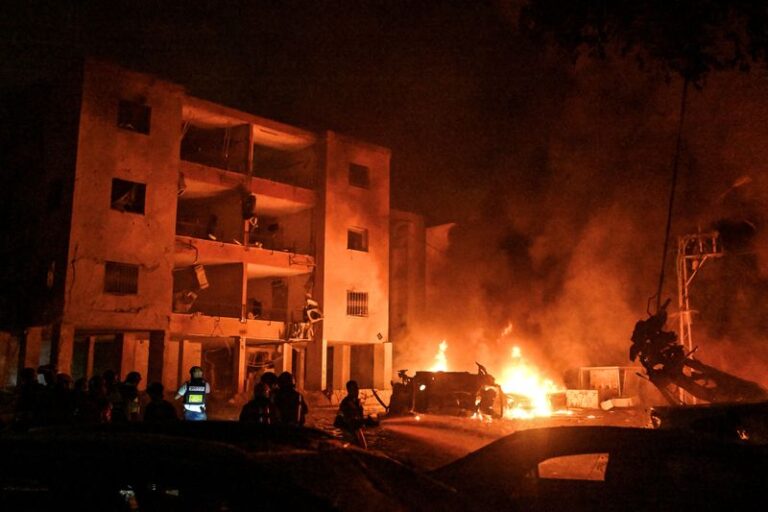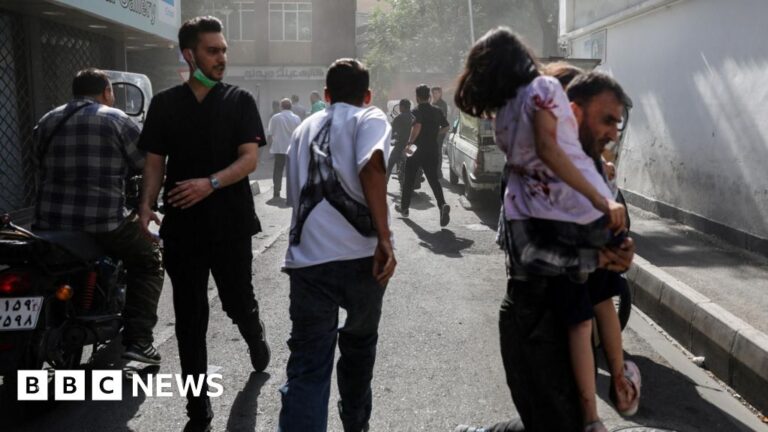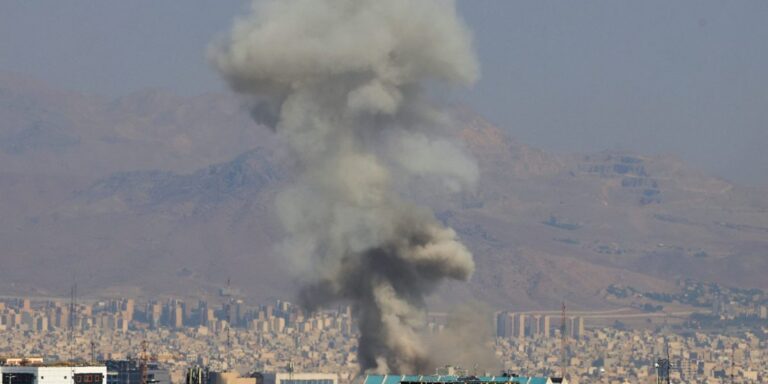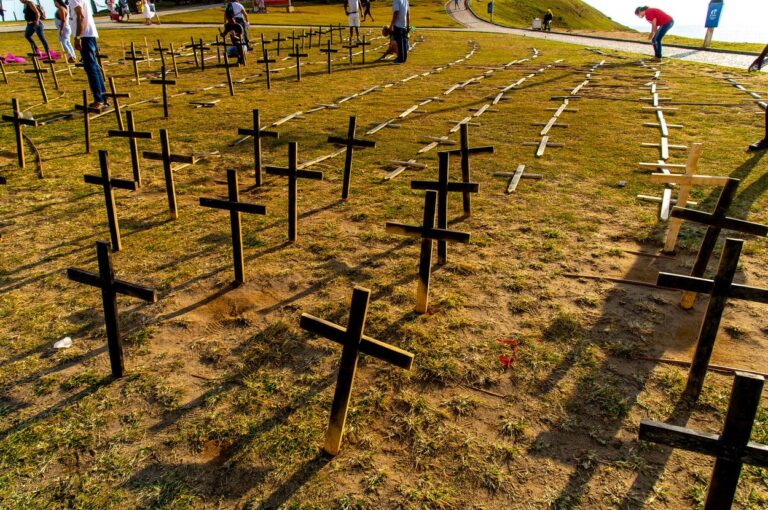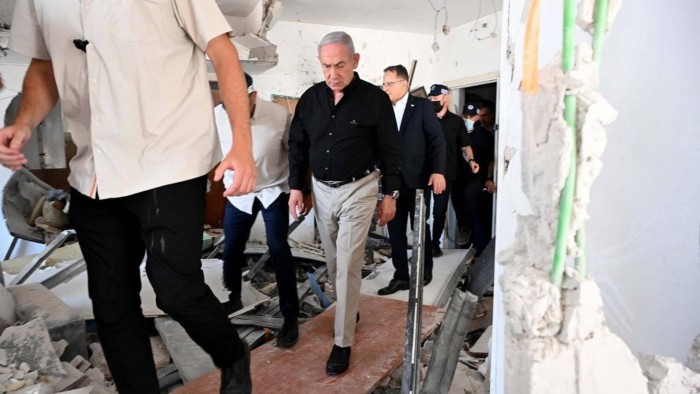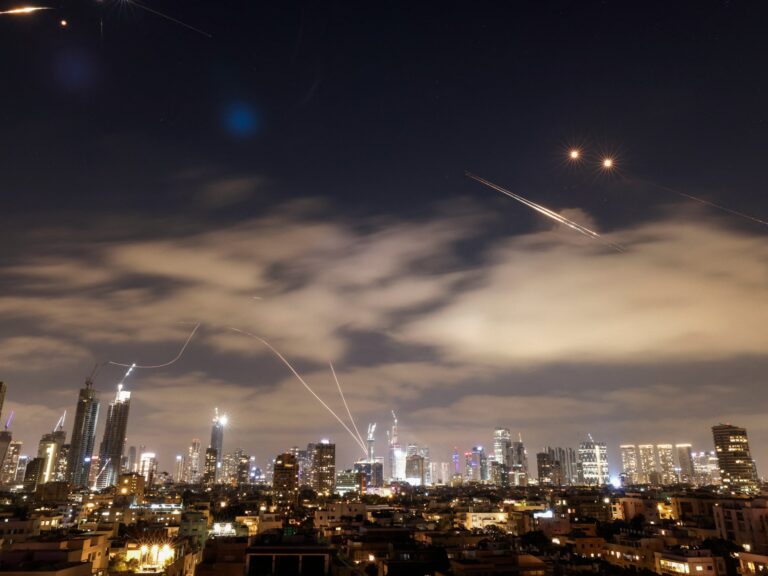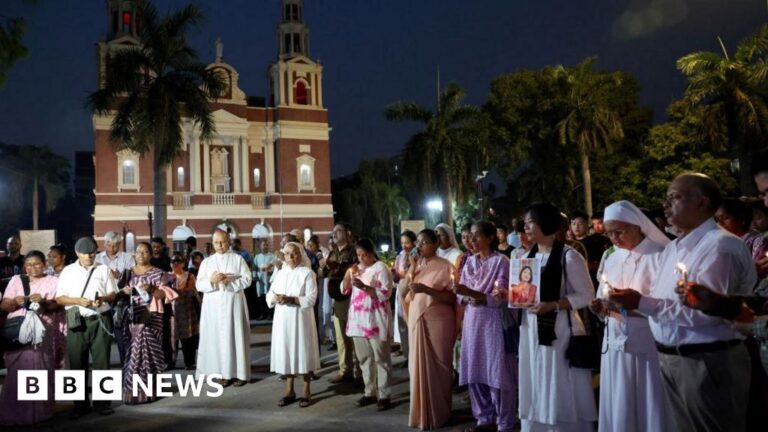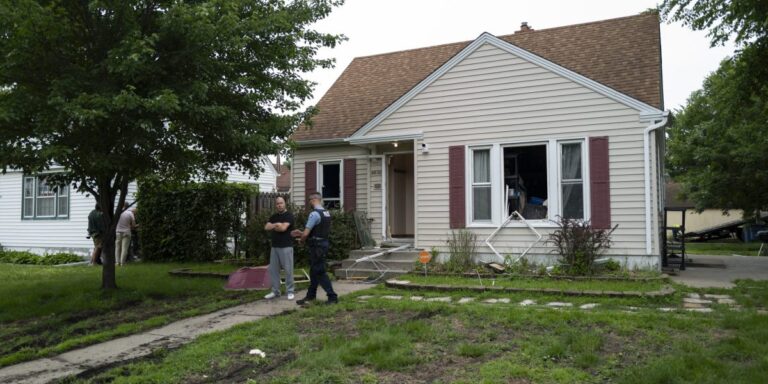Israel-Iran battle escalates, will be high on agenda as world leaders meet
Perspectives of Iranians living through Israeli attacks
“Stuck”. That is the word most people who have spoken to the BBC use to describe life in Iran right now.
After three days of Israeli attacks, “everyone is trying to escape” Tehran “one way or another,” one resident told BBC News Persian.
On Sunday, long queues formed at petrol stations across the city. Many people tried to leave for remote areas, away from any possible Israeli target, but could not even get out of the province because of heavy traffic.
“Tehran isn’t safe, clearly,” one resident said. “We get no alarms or warnings from officials about Israeli attacks. We just hear the blasts and hope our place isn’t hit. But where can we go? Nowhere feels safe.”
One person who managed to move from Tehran to another province said: “I don’t think I’ve fully processed that I’m living in an active war zone, and I’m not sure when I’ll reach acceptance.”
“This is not my war. I’m not rooting for either side, I just want to survive along with my family.”
Since Friday, Israel hit Iran with its biggest wave of air strikes in years.
Israel’s strikes have led to retaliation from Iran, which has launched missile attacks on Israel.
At least 10 people have been killed in Israel, authorities said. Iranian media, citing the health ministry, reported that 128 people had been killed in Israeli attacks as of midday on Saturday.
One Iranian told the BBC she has not been able to sleep for two nights: “I’ve gone through really tough situations.”
She said the current situation reminds her of bombings and going to shelters during the Iran-Iraq war of the 1980s, when she was a child.
“The difference is that back then, at least when an attack happened, we heard the air raid siren or at least warnings before it happened. But now, during this bombing or any air raid, there’s no sirens or warnings.”
Younger people, born after the war, do not know what it was like, BBC News Persian’s Ghoncheh Habibiazad said.
One woman in Tehran said she has considered leaving the city to escape the attacks.
“We’ve all wanted to go to smaller cities or villages, anywhere we can go, but each of us has loved ones who can’t leave, and we’re thinking of them,” she said. “What we’re experiencing is not fair to any of us, the people of Iran.”
“We’re all trying to get through these days in fear, exhaustion, and a lot of stress, this is extremely hard and painful.”
One resident in the capital said: “I can’t just leave Tehran. I can’t leave my elderly parents who can’t travel far and long and leave the city myself. Besides, I need to show up to work. What can I do now?”
The internet has been unstable, so it is very hard to keep in touch with people inside the country.
Many of those living outside the country are sending messages to loved ones, hoping for a reply.
Some people have also received warnings from the Israel military asking all Iranians to leave areas near military sites. People in Tehran seem most worried about this.
“How are we supposed to know where a military site is and where isn’t?” one said.
Separately, Israel’s Prime Minister Benjamin Netanyahu in a message to Iranians on the second day of the attacks said “the time has come” for Iranians to unite “by standing up for your freedom”.
However, people in the country have so far chosen to stay safe and there is little evidence that Netanyahu’s call has resonated on the ground, BBC News Persian’s Daryoush Karimi said.
Inside Iran, what perhaps shocked people the most was the destruction of residential buildings, even more than the attacks on nuclear facilities and airbases, said BBC News Persian’s Pouyan Kalani.
Many Iranians had not witnessed scenes like that since the end of the Iran-Iraq war – especially not on the streets of the capital.
Many of those in Tehran and elsewhere, recall the confusion of Friday: what exactly was happening; how widespread was it; and how could they protect themselves and their families?
Edited by Alexandra Fouché
Dow futures decrease as oil prices surge amid escalating Israel-Iran conflict aimed at vital energy assets
- Stock futures were mixed on Sunday as investors weighed the impact of the escalating Israel-Iran conflict that shows no signs of any potential off-ramps ahead. Oil prices jumped after Israel attack key areas of Iran’s energy infrastructure over the weekend, while Tehran said closing off the Strait of Hormuz was under serious consideration. Fed policymakers will meet in the coming week.
U.S. stocks signaled some weakness on Sunday night as futures tumbled and oil prices jumped amid the escalating Israel-Iran conflict that shows no signs of any potential off-ramps ahead.
Stocks sold off sharply on Friday after Israel launched an air campaign that struck Iran’s top military leadership, nuclear facilities, and bases around the country.
Over the weekend, both sides continued their bombardments with key areas of Iran’s energy infrastructure increasingly targeted. That includes oil refineries, fuel depots, and a massive natural gas field.
Futures for the Dow Jones Industrial Average fell 31 points, or 0.1%. S&P 500 futures were flat, and Nasdaq futures also edged up 0.1%.
U.S. oil prices jumped 2% to $74.50 per barrel, and Brent crude also shot up 2% to $75.77. That’s after oil soared 7% on Friday as markets reacted to the early stages of the Israel-Iran conflict.
An Iranian lawmaker said over the weekend that closure of the Strait of Hormuz, a critical chokepoint in the global energy trade, was under serious consideration. The equivalent of 21% of global petroleum liquids consumption, or about 21 million barrels per day, flows through the strait.
In a note on Saturday, George Saravelos, head of FX research at Deutsche Bank, estimated that the worst-case scenario of a complete disruption to Iranian oil supplies and a closure of the Strait of Hormuz could send oil price above $120 per barrel.
The yield on the 10-year Treasury slipped 1.7 basis points to 4.407%. The dollar fell 0.12% against the euro and 0.26% against the yen. Gold rose 0.47% to $3,468.10 per ounce.
Surging oil prices reignited inflation fears, just as consumer price data was showing more signs that President Donald Trump’s tariffs were having minimal impact so far.
That put upward pressure on the 10-year yield on Friday as hopes for rate cuts from the Federal Reserve later this year dimmed.
Inflation, tariffs, and the volatile geopolitical landscape will be top of mind when Fed policymakers are due to meet this Tuesday and Wednesday.
While they aren’t expected to adjust rates, they will release a fresh set of forecasts for future rates and economic indicators. Chairman Jerome Powell will also hold a press briefing on Wednesday afternoon.
This story was originally featured on Fortune.com
WHO Reports COVID-19 Death Toll Reaches 15 Million Globally
The problem is that 85 of the 194 countries surveyed by the WHO technical advisory group that came up with the new estimates don’t have good enough death registries for this to be a viable approach. Forty-one of those countries are in sub-Saharan Africa.
For these countries, a team led by Jonathan Wakefield, a statistician at the University of Washington in Seattle, used the data from countries with complete death registries to build another statistical model able to predict total COVID deaths in any month from other measures, including temperature, the percentage of COVID tests returning positive, a rating of the stringency of social distancing and other measures to limit infection, and rates of diabetes and cardiovascular disease — conditions that put people at high risk of dying from COVID.
The Indian health ministry objected strongly to this model in its response to the New York Times article. But the WHO team didn’t actually use it to estimate Indian COVID deaths. India falls into an intermediate group of countries that have reasonably good data on total deaths in some regions but not in others. So Wakefield’s team used data from 17 Indian states with adequate death registries, applied the standard excess deaths approach used for countries with complete death registries, and then extrapolated from these states to the entire country.
“We only base the predictions of how many people died in India in those two years on Indian data,” Wakefield told BuzzFeed News.
Importantly, the WHO’s estimates for Indian COVID deaths also align well with other studies, including one published in the journal Science in January by a team led by Prabhat Jha, director of the Centre for Global Health Research at the University of Toronto in Canada. Jha’s team estimated COVID deaths from Indian government data and from a national survey of 137,000 people, conducted by a polling company that asked people whether a family member had died from COVID. “India has pretty high cellphone coverage, and they did random digit dialing,” Jha told BuzzFeed News.
Jha’s team estimated that more than 3.2 million people in India had died from COVID by July 2021, the majority of them during the devastating surge in COVID caused by the Delta coronavirus variant between April and June 2021. That came after the government of Prime Minister Narendra Modi had relaxed COVID controls following an earlier, less severe wave. “The Indian government declared victory and said, ‘Oh India’s beat this virus,’ and complacency set in,” Jha said.
This explains the political sensitivity in India about accepting the results from studies that indicate a much higher death toll than the official count. Responding to a question from leaders of the opposition Congress party about Jha’s study in February, the Ministry of Health and Family Welfare described it as “speculative” and claimed it “lacks any peer reviewed scientific data” — even though it was published in one of the world’s leading peer-reviewed scientific journals.
“It’s politics,” Jha said of the Indian government’s rejection of his study.
According to the WHO, Egypt has proportionately the largest undercount of pandemic deaths, with excess mortality running at 11.6 times the toll attributed to COVID. India, with 9.9 times more excess deaths than its official COVID death count, is in second place. Russia, meanwhile, has reported 3.5 times fewer deaths from COVID than indicated by its excess mortality.
Ariel Karlinsky of the Hebrew University of Jerusalem, another member of the WHO technical advisory group, hopes the agency’s “stamp of approval” for excess mortality calculations will encourage nations to come up with more realistic numbers. “Putin doesn’t know who I am, but they do know who the WHO is,” he told BuzzFeed News.
But rather than moving to correct their COVID death numbers, some governments are apparently now withholding the all-cause mortality data used to calculate excess deaths. Belarus, which seems to be undercounting its COVID deaths by a factor of about 12, has stopped reporting its all-cause mortality data to the UN, Karlinsky said. “The sections on mortality just disappeared.”
Right now, the main concern is China, which is experiencing a significant wave of the Omicron coronavirus variant but is reporting suspiciously few deaths. If the wave now hitting Shanghai and other cities matches the pattern seen in Hong Kong since February, Jha fears that a million Chinese people may die.
Some countries have responded to excess mortality studies with greater accountability and transparency. After earlier excess deaths analyses suggested that Peru was underreporting its COVID deaths by a factor of 2.7, the South American nation went through its medical and death records in detail and revised its death toll in May 2021 to a figure closely matching the excess deaths analysis. It is now reporting the highest official per-capita death rate from COVID of any nation. “Peru did what I would have liked every country to do,” Karlinsky said.
The WHO’s new estimates of total excess pandemic deaths will include people who died from other causes because health systems were overwhelmed, as well as people killed by the coronavirus.
Karlinsky, who is an economist, said he started analyzing excess deaths because he wondered whether “the cure was worse than the disease” — in particular, he feared that lockdowns could cause more deaths than the coronavirus, in part through increases in suicides. But the data told a very different story.
In countries like New Zealand that had strict lockdowns but low levels of COVID, there is no excess deaths signal. There is also no evidence of a global epidemic of suicide during the pandemic — in the US, suicides actually decreased. Only in a few countries like Nicaragua, where people seem to have avoided going to the hospital because they were worried about getting infected, are there signs that deaths from other causes such as heart disease have increased, according to Karlinsky.
“Excess mortality is about equal to COVID mortality,” he added.
Netanyahu vows to take necessary actions with Iran’s leader
Unlock the White House Watch newsletter for free
Your guide to what Trump’s second term means for Washington, business and the world
Benjamin Netanyahu has warned his armed forces will “do what we need to do” with Iran’s leadership as he claimed regime change could “certainly be the result” of Israel’s attacks on the Islamic republic.
The Israeli premier’s remarks — in response to a question about assassinating Iran’s supreme leader Ayatollah Ali Khamenei — came after a weekend of escalating hostilities where the bitter foes traded strikes on cities and energy infrastructure.
Since launching its surprise assault on Friday, Israel has killed key figures in Iran’s military and nuclear programme and has launched air strikes across the country, pitching the two of the Middle East’s most powerful militaries into outright war.
Asked in an interview with Fox News whether ousting Khamenei’s regime was one of the goals of Israel’s assault, Netanyahu said it “could certainly be the result because the leadership is very weak”.
“Eighty per cent of the people would throw these theological thugs out,” Israel’s prime minister continued. “The decision to act, to rise up, is the decision of the Iranian people.”
A US official confirmed a Reuters report that Donald Trump had vetoed an Israeli plan to kill Khamenei. Netanyahu declined to comment on the report.
“But I can tell you, I think that we do what we need to do, we’ll do what we need to do. And I think the United States knows what is good for the United States,” he added.
Israel has long pursued an assassination policy against its enemies in the region. Its armed forces have decimated the top ranks of the Iran-backed militant groups Hamas and Hizbollah since Israel was attacked by Hamas on October 7, 2023.
Netanyahu spoke after Trump earlier on Sunday called for a deal between the warring parties, saying “many calls and meetings” were now taking place that would lead to peace soon. “Iran and Israel should make a deal, and will make a deal,” he wrote on Truth Social.
In a later call to ABC News, Trump said also Russian President Vladimir Putin was “ready” to mediate — adding that he was “open” to the idea and had discussed it with his Russian counterpart.
But despite Trump’s remarks Israel and Iran continued to trade strikes on Sunday.
Israeli officials said Israel’s armed forces had carried out strikes on more than 80 targets, including the defence ministry, military and nuclear sites, as well as at least two energy facilities. Iranian state media reported that Israel had carried out numerous attacks across Tehran including at least two in residential neighbourhoods in the city centre, and struck a major water pipeline, causing leaks in northern parts of the capital.
Online videos also showed columns of fire and smoke rising in downtown Tehran and other parts of the city, and police reported heavy traffic at Tehran’s exit routes, signifying many residents were leaving the capital for safer cities. Explosions were reported in Mashhad, Iran’s easternmost city, in a sign of Israel expanding its assault across the country.
At least 224 Iranian civilians have been killed in Israeli strikes since Friday, according to the health ministry. Hossein Kermanpour, Iran’s health ministry spokesperson, said in a post on X that this demonstrated the Israeli government’s claim of supporting the Iranian people was a “false slogan”.
Meanwhile, Iran continued to fire barrages at Israel. Israeli authorities said at least 13 people have been killed and hundreds injured since the outbreak of hostilities on Friday. Refining infrastructure at the port of Haifa was hit in Sunday’s strikes, according to a regulatory filing from the Bazan group.
Officials from the two countries also continued to trade threats, with Israel’s defence minister Israel Katz threatening to inflict similar destruction on Tehran as it did on Beirut in its offensive against the Lebanese militant group Hizbollah last year. Iran’s President Masoud Pezeshkian pledged a “more painful” response should Israel continue its onslaught.
Key Events in Israel-Iran Conflict on June 15, 2025 | Latest Israel-Iran Conflict Updates
Here are the key events on day three of the Israel-Iran conflict.
Here’s where things stand on Sunday, June 15:
Fighting
- Iran fired two separate salvoes of missiles and drones against Israel, including one that struck the Israeli port city of Haifa. At least 15 people were injured.
- Israel also fired a barrage of missiles against Iran, targeting several locations, including the capital Tehran, a Foreign Ministry building there, a military base of the Defence Ministry in Isfahan, and an aerial refuelling aircraft at Mashhad Airport.
- In Israel, rescue workers were searching for survivors in the rubble from the previous night’s wave of Iranian strikes. The hardest hit area was the town of Bat Yam, where dozens of buildings were damaged.
Casualties and disruption
- At least 128 people were killed by Israeli attacks across Iran on Friday and Saturday, Iran’s Health Ministry has been quoted by local media as saying.
- Overnight, Iran struck the Israeli port city of Haifa and neighbouring Tamra, where at least four women were killed.
- Since the start of the conflict on Thursday, at least 13 people have been killed and 380 have been wounded in Israel.
- The Israeli Civil Aviation Authority has announced a complete closure of airspace and airports. Iranian airspace is also closed.
Diplomacy
- Iran’s Foreign Minister Abbas Araghchi said Tehran does not seek to expand the conflict to neighbouring countries unless forced to.
- Araghchi also said Iran has “solid evidence” of the support provided by the United States to Israel’s attacks.
- Talking to Fox News, Israeli Prime Minister Benjamin Netanyahu seemed to clearly confirm that, saying he informed US President Donald Trump ahead of launching the attacks.
- Netanyahu also projected that regime change in Iran could be a result of Israel’s attacks.
- Trump warned Tehran not to widen its retaliation to include US targets and didn’t rule out more direct US involvement beyond the vast arsenal and intelligence the US provides to Israel.
- Contrarily, the US president also claimed peace could be reached “soon”, suggesting that many diplomatic meetings were taking place.
- He also said he would be “open” to his Russian counterpart President Vladimir Putin serving as a mediator.
- French President Emmanuel Macron rebuked that idea, saying it would not be a good idea to have Putin, embroiled in his own war in Ukraine, as a mediator in the Israel-Iran conflict.
- European Union foreign policy chief Kaja Kallas has called a videoconference of EU foreign ministers for Tuesday to discuss the Middle East crisis.
- Hopes for a diplomatic solution seem distant for now, though they will no doubt be high on the agenda of the Group of Seven summit beginning Monday in Canada.
Macron dismisses Trump’s suggestion of Putin mediating Israel-Iran conflict
Macron rejects Trump's idea for Putin to mediate Israel-Iran crisis
Death toll in Air India plane crash increases to 270
Doctors in India say 270 bodies have been recovered from the site of Thursday’s plane crash in Ahmedabad.
The London-bound aircraft crashed into a residential area shortly after take-off killing all but one of the 242 passengers and crew members, a 40-year-old British man.
Officials have also been trying to establish how many people were killed on the ground and have been continuing the slow process of matching DNA samples to confirm the victims’ identities.
Vigils honouring the dead have taken place across India and the UK.
About 100 people gathered outside the High Commission of India in London on Sunday, with many laying candles in memory of those who died in the crash.
One community leader said they had been in touch with a family who had flown to India to identify the remains of their loved ones and were waiting in hospital for the results of DNA matching.
Many people at the gathering want answers on how and why the incident could have happened, the community leader said.
India’s Aircraft Accident Investigation Bureau (AAIB) is leading the inquiry into the cause of the crash, helped by teams from the US and UK.
On Friday, a black box was found at the site of the crash which India’s civil aviation minister, Ram Mohan Naidu Kinjarapu, said would “significantly aid the inquiry” into the disaster.
Less than 60 seconds after leaving Ahmedabad’s Sardar Vallabhbhai Patel International Airport, the plane lost altitude and crashed into a building that was used as doctors’ accommodation at the BJ Medical College and Civil Hospital.
On Saturday, the President of the Junior Doctors’ Association of the college, Dr Dhaval Gameti, confirmed the hospital had received the bodies of 270 victims.
Of those, 241 are believed to be passengers and crew of Flight AI171.
More than thirty victims have also been formally identified using DNA samples provided by relatives.
According to data by tracking website, Flightradar24, the Boeing Dreamliner 787-8 was 11 years old and had operated 25 flights from Ahmedabad to London Gatwick in the past two years.
In response to Thursday’s crash, India’s aviation regulator, the Directorate General of Civil Aviation (DGCA), ordered additional safety checks on Air India’s Boeing 787-8 and 787-9 fleet, describing it as a “preventive measure”.
India’s Prime Minister Narendra Modi spent around 20 minutes walking around the site of the plane crash on Friday.
He also visited the hospital to meet some of those injured in the disaster, including the sole plane survivor Vishwashkumar Ramesh, later saying that “the entire nation is praying for their speedy recovery”.
Air India CEO Campbell Wilson also went to the crash site on Friday and described the visit as “deeply moving”.
Minnesota shooting suspect sought employment while performing odd jobs, before using bank funds to pay rent for four months prior to the attack
- The man that authorities say is a suspect in the shooting of two Minnesota lawmakers on Saturday had a complex financial and professional history. While he signaled he was open to job opportunities in the food industry, he reportedly worked at a funeral home while also served as director of security patrols at a private-security firm.
Vance Boelter, who was named as a suspect in the shooting of two Minnesota lawmakers on Saturday, left behind a complex financial and professional history.
He remains on the run with a manhunt underway. State Rep. Melissa Hortman, 55 years old, and her husband were shot and killed in their Brooklyn Park home. Elsewhere in Champlin, state Sen. John Hoffman, 60, and his wife were also shot at home and are recovering after undergoing surgery. Gov. Tim Walz described the shooting as “an act of targeted political violence.”
While Boelter was listed as director of security patrols for private-security company Praetorian Guard Security Services, it’s unclear if that was his primary source of income.
He worked for an eye donation center, according to David Carlson, who shared a house in Minneapolis with Boelter and told Reuters he’s known him since fourth grade.
Carlson also said Boelter was working at a funeral home while experiencing financial and mental health challenges, according to the New York Times.
On Friday, Boelter gave Carlson four months of rent in advance, or about $900 total. A federal law enforcement official told the Times that Boelter emptied a bank account before the shooting.
Despite his various jobs, Boelter’s LinkedIn profile picture carries the green “#opentowork” banner. His professional history includes a stint as a 7-Eleven general manager as well as various positions at food companies like Greencore, Del Monte, Johnsonville Sausage, and Nestle.
“Hi everyone! I’m looking to get back into the U.S. Food Industry and I’m pretty open to positions,” he posted a month ago. “Other Leadership positions outside of the Food Industry I’m willing to hear about as well.”
The LinkedIn profile also says Boelter is CEO of Red Lion Group in the Democratic Republic of Congo, where he has delivered sermons as a pastor, according on online videos.
In addition, he and his wife once led a Christian nonprofit called Revoformation Ministries, according to the Times, which cited an archived version of a website that said Boelter previously traveled to the Gaza Strip and West Bank where he “sought out militant Islamists in order to share the gospel and tell them that violence wasn’t the answer.”
Boelter is also listed on federal tax forms as the president of a Minnesota-based nonprofit called You Give Them Something to Eat, though there’s no indication of any spending or income, according to the Washington Post.
His housemate Carlson said Boelter was against abortion and voted for President Donald Trump but generally avoided talking about politics.
He shared with local media text messages he got from Boelter before the shooting that suggested something dire was about to happen.
“I made some choices, and you guys don’t know anything about this, but I’m going to be gone for a while. May be dead shortly, so I just want to let you know I love you guys both and I wish it hadn’t gone this way.”
This story was originally featured on Fortune.com
High School Rankings for Regional and National Categories in 2024

MAX Field Hockey is excited to release the Final High School Regional Top 20 and National Top 25 Rankings for the 2024 High School season! Congratulations to all of the selected teams, including the #1 Ranked “National Champions” The Hill School (Pottstown, Pennsylvania). The Rams clinched the PAISAA and MAPL titles with a perfect 22-0 finish, outscoring opponents 115-6, including victories over 7 teams in our Final National Top 25 Rankings. They were simply unstoppable this Fall and maintained the #1 spot in the nation straight through the season from our Preseason Rankings.

2024 National Champions: The Hill School (Pottstown, Pennsylvania)
2025 MAX FIELD HOCKEY/LONGSTRETH HIGH SCHOOL NATIONAL INVITATIONAL
The 2025 MAX Field Hockey/Longstreth High School National Invitational is scheduled for September 19-21, 2025 at The Proving Grounds in Conshohocken, Pennsylvania. Teams finishing in the Final 2024 MAX Field Hockey’s Team Ranking (Regional and/or National) are automatically invited to the 2025 National Invitational. “Others Considered” teams will need to submit an application. We are encouraging additional interested teams to submit an application and we will evaluate those as they come in. We will look at overall program strength, 2024 performance, and expected team strength in 2025.
Due to the incredible interest in this event from teams across the nation, we are making some slight changes to the registration process and timeline to ensure that we are able to make the schedule work, maintain the highest level of competition, and maintain our PIAA and NFHS sanctioning for the event. In early January, we will release the exact details of the registration process and specific timeline that teams will be able to register. If you would like to be notified when we release this information- please fill out the following: INTEREST FORM.
POSTSEASON TOURNAMENT COVERAGE: Congratulations to all of the 2024 State and Major Conference Champions! Check out our compiled postseason coverage by state, including final brackets and championship team pictures on our POSTSEASON COVERAGE page (Main Menu Bar: High School => Postseason Coverage). Please email any missing postseason brackets, links and tournament information to admin@maxfieldhockey.com.
STATE & LOCAL AWARDS: Each Fall we compile athlete awards from across the country by state at our High School State & Local Awards Central (Main Menu Bar: High School => Player Awards => 2024 State & Local Awards). We refer to these awards in our All-Region & Player Ranking decision making. Please email any missing local/state player awards to admin@maxfieldhockey.com.
2025 CONTENT & EVENT CALENDAR: Please check out our recently released 2025 CONTENT & EVENT CALENDAR. We have received a lot of questions about upcoming Player Rankings and how to submit recommendations. We will release more details on this towards the end of next week. Stay tuned.


